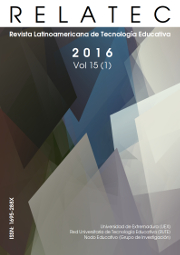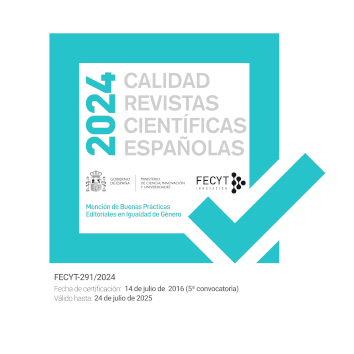Análisis comparativo de las prácticas docentes con recursos TIC. Estudio de casos con profesores de Infantil, Primaria y Secundaria / Comparative analysis of classroom practices with ICT resources. Case Studies with teachers from Early Childhood Education
DOI:
https://doi.org/10.17398/1695-288X.15.1.11Keywords:
Tecnología educativa, Prácticas de clase, Educación Infantil, Educación Primaria, Educación Secundaria.Abstract
El presente artículo pretende estudiar cómo varios profesores de distintas etapas educativas incorporan a sus prácticas diversos recursos tecnológicos, sean equipos informáticos especialmente adaptados para edades tempranas u otros como pizarras digitales interactivas en conjunción con otros soportes. Para realizar el estudio, se han registrado en vídeo el desarrollo de las clases y, posteriormente, mediante un sistema de categorías que permite desmenuzar lo que ocurre en las clases, se han analizado las prácticas de aula. Los resultados corroboran estudios anteriores sobre incorporación de las Tecnologías de la Información y la Comunicación (en adelante TIC) y permiten afirmar que los profesores gestionan el uso de estos recursos a través de distintos patrones de actividad que adquieren sentido en relación con la finalidad curricular de cada sesión. Asimismo, se constata que las tecnologías adoptan un papel subsidiario: el profesor se apoya en ellas para desarrollar las tareas y los contenidos y no cambia su forma de actuar por incorporar el recurso digital.
ABSTRACT
This paper tries to examine how various teachers from different educational levels integrate into their practice technological resources, computer equipments designed to be used with children at early ages or whiteboards combined with other hardware. Using a system to analyze classroom interaction that allows us to segment teaching practice into categories differentiated by level of generality, we studied recordings of various classroom sessions with the ICT resources. The results confirm the conclusions reached by previous studies on the Information and Communication Technologies educational uses and be able to affirm that teachers managed their practices by activity patterns where digital resources get sense in relation with the curricular goals of each session. Likewise, the results confirm that ICT resources play a secondary role: the teacher rely on them for support in the management and presentation of classroom tasks and contents. Also, teachers do not change their usual classroom performance when they incorporate the digital resource.
Downloads
References
Area, M. (2010). El proceso de integración y uso pedagógico de las TIC en los centros educativos. Un estudio de casos. Revista de Educación, 352, 77-97.
Bejarano, J. (2010). El currículum de la Educación Infantil. En J. Gimeno (ed.) Saberes e incertidumbres sobre el currículum, (pp.399-420). Madrid: Morata.
Clemente, M., Ramírez, E., Borgaz,B. y Martín, J. (2011). Recursos digitales y prácticas de clase: Esquemas de acción de profesores de Educación Infantil. Revista de Educación, 356, 211-232. Recuperado a partir de: http://www.revistaeducacion.educacion.es/re356/re356_09.pdf
Clemente, M., Cañedo, I. y Martín, J. (2012). Incorporating Internet resources into classroom practice: Secondary school teacher action plans. Australasian Journal of Educational Technology, 28(8), 1433-1450. http://dx.doi.org//10.14742/ajet.780
Cuban, L. (2001). Oversold and underused. Computers in the Classroom. Cambridge, MA: Harvard University Press.
Doyle, W. (1987). The Classroom as a Workplace: Implications for Staff development, en M. Wideen and I. Andrews (ed.). Staff Development for School Improvement, (pp. 38-54). London: The Falmer Press.
Gimeno, J. (1996). La transición a la educación secundaria. Madrid: Morata.
Hennessy, S., Ruthven, K., & Brindley, S. (2005). Teacher perspectives on integrating ICT into subject teaching: commitment, constraints, caution, and change. Journal of Curriculum Studies, 37(2), 155-192. http://doi.org/10.1080/0022027032000276961
Hinostroza, J.E., Labbé, C., Brun, M., & Matamala, C. (2011). Teaching and learning activities in Chilean classrooms: Is ICT making a difference? Computers & Education, 57(1), 1358-1367. http://doi.org/10.1016/j.compedu.2011.01.019
Jiménez, J. (2010). El currículum de la Educación Primaria. En J. Gimeno (ed.) Saberes e incertidumbres sobre el currículum, (pp.421-438). Madrid: Morata.
Leinhardt, G. (1990). Capturing Craft Knowledge in Teaching. Educational Researcher, 19(2), 18-25. http://doi.org/10.2307/1176598
Marcelo, C.; Yot, C.; Sánchez, M.; Murillo, P. y Mayor, C. (2011). Diseñar el aprendizaje en la universidad: Identificación de patrones de actividades. Revista de Currículum y Formación del Profesorado, 15(2), 181-198.
Montero, L. y Gewerc, A. (2010). De la innovación deseada, a la innovación posible. Escuelas alteradas por las TIC. Revista de Currículum y Formación del Profesorado, 14(1), 303-318.
Munro, R. (2010). Setting a new course for research on information technology in education. In A. McDougall, J. Murnane, A. Jones & D.
Reynolds (Eds.), Researching IT in education (pp. 46-53). Oxon: Routledge.
Pablos Pons, J. de; Area Moreira, M.; Valverde-Berrocoso, J. y Correa Gorospe, J.M. (2010). Políticas educativas y buenas prácticas con TIC. Barcelona: Graó.
Peterson, P. L., Marx, R. W., & Clark, C. M. (1978). Teacher Planning, Teacher Behavior, and Student Achievement. American Educational Research Journal, 15(3), 417-432. http://doi.org/10.3102/00028312015003417
Putnam, R. T., & Borko, H. (2000). What Do New Views of Knowledge and Thinking Have to Say about Research on Teacher Learning? Educational Researcher, 29(1), 4-15. http://doi.org/10.2307/1176586
Sosniak, L.A. & Stodolsky, S. (1993). Materials use in four fourth-grade classrooms. The Elementary School Journal, 93(3), 249-275.
Stake, R.E. (1995). The art of case study research. Thousand Oaks, CA: Sage.
Wallace, R. M. (2004). A Framework for Understanding Teaching With the Internet. American Educational Research Journal, 41(2), 447-488. http://doi.org/10.3102/00028312041002447
Windschitl, M. (2004). What types of knowledge do teachers use to engage learners in «doing science»? Paper commissioned by the National Academy of Sciences. Washington, DC: Board of Science Education .Disponible en: http://www7.nationalacademies.org/bose/mwindschitl_comissioned_paper_6_03_04_hslabs_mtg.pdf
Yinger, R.J. (1980). A study of teacher planning. The Elementary School Journal, 80(3), 107-127.
Zahorik, J. A. (1975). Teachers’ Planning Models. Educational Leadership, 33(2), 134-139.
Downloads
Published
Issue
Section
License
Authors who publish in this journal accept the following conditions:
1. The Author retains copyright in the article. Upon acceptance of the article, the author shall grant to the Publisher the right of first publication of the article. with the dcoument registered with the Creative Commons Attribution-NonCommercial-NoDerivative 4.0 International (CC BY-NC-ND) license, which allows to third parties to use what is published whenever they mention the authorship of the work and the first publication in this journal.
2. Authors can make other independent and additional contractual agreements for the non-exclusive distribution of the article published in this journal (eg, include it in an institutional repository or publish it in a book) provided they clearly indicate that the work was published for the first time in this journal.
3. Authors are allowed and recommended to publish their work on the Internet (for example on institutional or personal pages) before and during the review and publication process, as it can lead to productive exchanges and a greater and faster diffusion of published work (see The Effect of Open Access).









